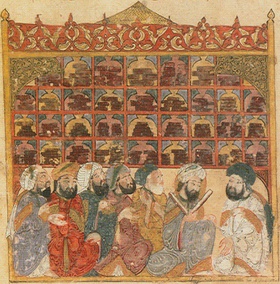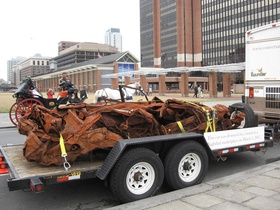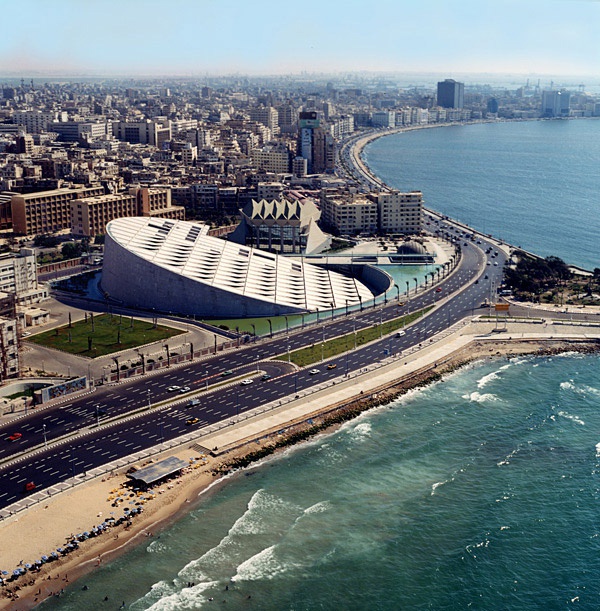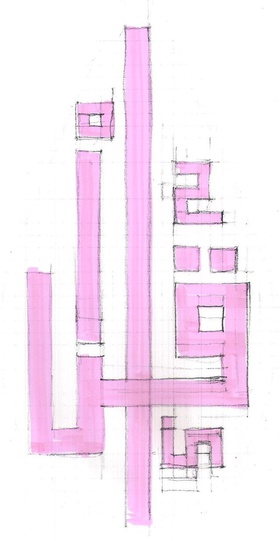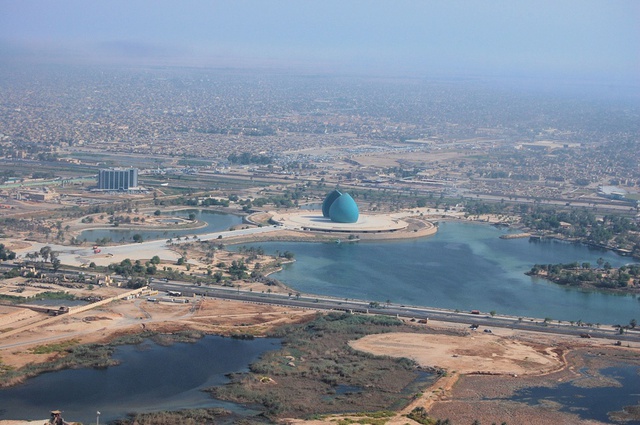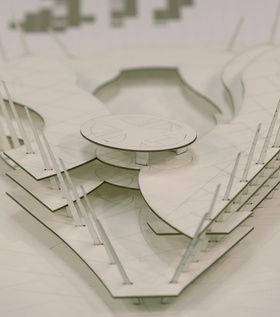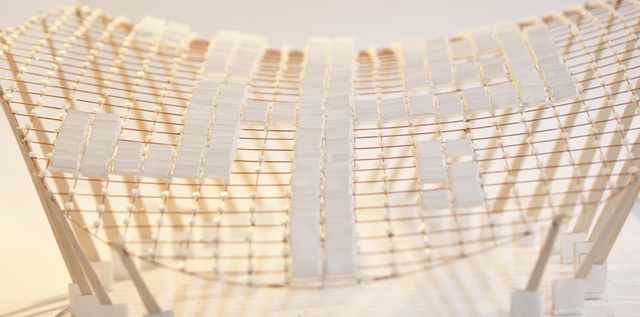Essays
Designing the Future
What Does It Mean to Be Building a Library in Iraq?
An old Arab adage of the twentieth century goes like this: 'Cairo writes, Lebanon publishes and Baghdad reads.'
The idea of building a new library in Iraq has been met with equal measures of impassioned hope as much as worn cynicism. AMBS Architects were commissioned to design a new library for Baghdad by the Ministry of Youth and Sport in November 2011. The supposedly simple brief of 'a modern library' for the 'youth' of Baghdad, as presented by the Ministry of Youth and Sport, required an exercise in re-learning and questioning the conventional model of a library. Our investigation into what a new library in Iraq could be was primary. The idea of 'youth' as an audience is especially significant given 63 per cent of Iraq's population are under 24, with nearly 12.8 million (43 per cent) of these under the age of 15, and a further 15 per cent between the ages of 25 and 35. Thus, we posed the question – how might people, especially young people, engage with learning in the future?[1]
Iraq's youth have been brought up surrounded by violence and instability. For the past decade educational services have rapidly deteriorated and opportunities for work and personal development have declined. When AMBS's founding director Ali Mousawi returned to Iraq in 2003, what he saw and still sees today is that the Iraqi youth are in many ways lost. Before 2003, Iraq had almost collapsed after a 13-year embargo and eight years of war. This kept the country isolated from the world and from modern technology.
From the beginning, the question of what such a library can pose for the future of Iraq has been a reoccurring one. The recent turbulent history of over a decade of conflict during the occupation has left Iraq relatively isolated from the rest of the world. The neglect of Iraq's cultural resources has meant much of Iraq's literary history has been lost. Today there is a strong will to rebuild in Iraq and this project brings the hope of the re-ascendancy of intellectual life in Baghdad. As such, conceptualizing the library has demanded an understanding of the complex context and significance of raising a new library.
The Director of the Iraq National Library and Archives (INLA), Dr Saad Eskander who has played a valuable role in preserving Iraq's literary heritage wrote about the new library:
It is imperative for the new Iraq to consolidate its young democracy and good governance through knowledge. New libraries have a notable role to play by promoting unconditional access to information, freedom of expression, cultural diversity and transparency. By responding to the needs of Iraq's next generation, the new library, we hope, will play an important role in the future of our country. [2]
This essay explores the role this new library could play, the relevance of building such an institution and the implications of establishing a new platform for Iraq's cultural history. Until recent times the role of the library, as a fixed and physical place of learning, to find books has remained relatively constant. Then there is the challenge of addressing sustainability and fuel security in an oil rich nation. As architects, it is interesting to mediate these different contradictions. Therefore, this text also lays out some of these challenges and what lessons have been learnt through the process of designing a new cultural institution for Iraq.
A brief history of books in Iraq
'New knowledge and also the technology born of knowledge, may be most recent, futuristic even, but our library will be concerned just as well with that of the past'
– Rashad Salim
To look forward into the possibility of a new kind of library, one might look back to the ninth century when they referred to the Great Library of Baghdad as the 'House of Wisdom'.
Indeed, one cannot discuss this library without understanding the legacy of books in Iraq, which – as we have learnt – has been a turbulent and tragic one. During the Abbasid rule in the ninth century, the area we now call Baghdad had 36 libraries, the main one of which was not referred to as a library, but Bayt al-Hikma or the House of Wisdom. It was home to astrologers, scholars, architects, mathematicians, medics, and geographers from all over the world. It marked the 'Islamic Golden Era' and was a place associated with all forms of knowledge, where scholars would travel the world to collect and translate texts from neighbouring Persia and India, to as far west as Ancient Greece and Rome and as far east as China. By the mid-ninth century, the House of Wisdom was the largest repository of books in the world.
In 1258, during the 'Seige of Baghdad', the House of Wisdom was sacked by the Mongols and burnt down. The siege is believed to have marked the end of the Islamic golden era and Baghdad's literary institutions never really recovered. Thousands of texts contained within the House of Wisdom were thrown into the Tigris River, which according to legend turned the river's waters black with ink. Yet, Nasir al-Din al-Tusi, a much-respected scholar and theologian of the time, was believed to have rescued around 400,000 manuscripts.[3]
In 1920 a new library was established in Baghdad, with the help from English explorer Gertrude Bell, which became the existing National Library and Archives. With the occupation in 2003, the INLA was also burnt, sacked and looted. Dr Saad Eskander, who became Director of the Library and Archives after the attack, recorded the full extent of the INLA's losses as follows: archival materials – 60 per cent lost; rare books – 95 per cent lost; manuscripts – 25 per cent lost.[4]
The painful destruction continued and in 2007 the world witnessed the obliteration of al-Mutanabbi Street by a car bomb. Named after a great medieval Arab poet, the street was famous for its many book stores, publishing houses and a Friday book market. Eskander witnessed the bomb recalling, 'tens of thousands of papers were flying high, as if the sky was raining books, tears and blood'. [5] The street was also a vital resource for the INLA, which purchased about 95 per cent of new publications from al-Mutanabbi Street.[6] A number of the publishers and booksellers Eskander knew personally were among the 130 injured or killed.
The attack on al-Mutanabbi Street was felt across the world and many international artist and writers responded to the event. San Francisco poet and bookshop owner Beau Beausoleil founded arts project Al-Mutanabbi Street Starts Here (2007–ongoing) because the atrocity 'resonated with the international cultural community'.[7] British artist Jeremy Deller famously managed to acquire the remains of the shelled out car bomb from that day in a project called It Is What It Is (2009). He toured the remains around the USA with a sign detailing the provenance of the car, as a means to engage people in a conversation about the Iraq war.
Unsurprisingly, these continuous attacks on Iraq's intellectual history have ingrained cynicism amongst the Iraqi people. Iraqi artist and activist Rashad Salim describes it as:
a two decade long crime wave, a serial destruction of looting of libraries. Iraq has been repeatedly denied access, time and again to her own library. However the latest attempt at denial and closing of doors, differs fundamentally from all those that preceded, in that the sum of our knowledge, art and thought has never been so extensive, as in this age.[8]
As such, designing a new library for Baghdad is to walk on consecrated ground. Selim said a new library would unavoidably be a 'memorial to this holocaust, a word that means a burning destruction'. Therefore, the construction of a new library inevitably embodies the rise from the all too literal ashes and is closely tied to the memory of former literary institutions. This new library is being born out of a long and troubled lineage, but the founding principle of sharing knowledge has endured both violent destruction and a legacy of obstinate negligence.
A new model
There is an interesting history to the topology of the Baghdad library site. A library is typically expected to exist in an academic context, but here it is in a leisure context, which gave the design some freedom from traditional boundaries. Near the library's location, there is marshland, an abandoned funfair, a monument, various Ministry headquarters, and a gymnasium building designed by Le Corbusier. The gymnasium was built posthumously in 1982, but was originated from Le Corbusier's Olympic city master plan for Baghdad, which was conceived in the 1950s. These accumulated iterations of use define the identity and the meaning of the place; the literal layers of archaeological and architectural remains and the figurative accumulation of ideas over time, reinforce a complex image of the site. It is important to recognize Baghdad's history as a modern city and allow the possibility of marrying the traditional and modern together within a cultural institution.
An example of this balance between past and present is evident in Snøhetta Architects' Bibliotheca Alexandrina in Egypt (2001), which carefully commemorates the Great Library of Alexandria and is also a statement of modern literary achievements and contemporary Middle Eastern culture. The Baghdad library design also required a modern-day approach that was appropriate to the historic character of the area and that would thoughtfully translate it into contemporary architectural vocabulary. This shift seeks to expand the scope of libraries, without eroding their essential role as places of wisdom These expanding possibilities: the new interfaces that now exist, the different ways people are engaged and can educate themselves, were drivers for the production of a dynamic library model for the youth of Iraq. Salim described the library as the 'sum of knowledge'; that this is what the Baghdad library should be.[9] New digital technology is just one means of conveying knowledge; all means are important and have to be used.
As such, the Baghdad Library will be much more than just an iconic structure. However unconventional, what makes this building truly remarkable is the interface with the user. Our library's architecture goes beyond function: it is about the building's behaviour and how the building will engage with the user. Rather than claiming an intellectual position, we try to articulate notions of situation and mediation. Our architectural approach rejects style, signature and even concept in favour of a form of intelligence combining wisdom, creative and strategic thought, delicacy, resourcefulness, skill and experience. The design method we systematically practise is structured around deductive reasoning; the building needs to work; thus we need to apply general premises and refine possibilities until we reach specific parameters. Thoughts and ideas give shape to a set of spaces, and little by little, an ideal model is deduced.
With the library we kept talking about this 'object of desire', a building at the forefront of technology that is also deeply embedded in cultural significance. It was important that navigation through the building would be intuitive and user-friendly; visitors can understand the space and visually connect to it in anticipation. The library was imagined as essentially one uninterrupted space that the user can easily understand and where different events and scenarios can happen simultaneously.
We pursued the idea of cognitive intelligibility; that the whole internal arrangement could be understood at a glance. To achieve such a space with the kind of spans that we envisioned, we looked at the structural technology in large sports venues. This gave us a circular plan, but to make it easily legible we needed to introduce a key factor: direction. Elongating the structure to create a 'head and tail' was a method of informing the user, in a matter-of-fact way, where they are in the building at all times by addressing the main entrance at the tail, and connecting it with the surrounding lake at the head. This is how the idea of the central 'valley' came about, with the fluid stepped levels cascading and overlooking each other. The visual connection with roof also guides the reader around the library as a reference point.
These initial discussions gave us a set of ideas to form an elementary model, from here continuous layers of complexity were negotiated and then a traditional process took over: drawing, sketching, physical and computational modelling. The principle that the model was deduced is important because it demonstrates a process of refinement, from general to specific, that is dependent on the context, rather than the imposition of a predetermined shape or style.
A sense of ownership was something important to instill in the library, to allow it to become a kind of internalized public space that could be cultural, social and educational. The need to create vast open man-made spaces has been a hallmark of authoritarian control. In the essay, 'Who's Afraid of Public Space?' Amale Andraos notes that large open public spaces in the Middle East are often the signal of dictatorship and oppressive state regulation.[10] The heat in Iraq also makes it a physical impractically to impose monumental outdoor spaces. In the library, ownership is conveyed through the open, flexible design, which allows for variable internal organization; only the vertical circulation is fixed to allow for future adaption. From entering the building at the narrow tail of the building, the wide 'valley' floor plan of the central reading room is opened up to be read. Views to the tiered levels are designed to induce intrigue and the curved, terraced floors communicate fluid paths and encourage exploration of the library. The central valley is imagined as a multi-functional events space to be defined by the people who use it. In this sense our intention was that the library model would flexible enough to adapt to the needs of future users.
There is something to be said about the history of social spaces in Iraq and the Arab world. Throughout history there were communal social spaces that included libraries, mosques and private homes, where people would gather and work or socialize. It prevails in contemporary culture and we see examples of communal public spaces all over the world. There is a need and ever growing importance in providing spaces like this in Iraq today, which enable young people in particular to interact. For Iraqis this may mean; 're-finding our own literacy' as Salim put it.[11]
The influence of the written word is etched into the history of Baghdad and is likewise infused into this new place of learning. The light that illuminates our library, filters through the Arabic word, ikra – read, encrypted in the roof sky lights and etched in Kufic script. Kufic is one of the earliest known systems of writing, a calligraphy that derived from the ancient city of Kufa in Iraq in the seventh century. It is also worth noting that the word ikra is written in the Qur'an as the first word spoken from God to the prophet. This, for some, emphasizes the sacrosanct nature to the pursuit of knowledge. The very notion of the library is integral to Iraqi identity and thus the desire to erect or resurrect 'Our Library' (as Salim refers to it), provides new hope and countless possibilities.
The safe passage of a modern library in Iraq
I see the library as an ark of the recorded experiences of collective humanity. An ark metaphorically speaking ... visually and also on a very practical sense; to weather the storm, the flood of wars and conflicts, the massive social, medical and environmental ramifications, and the climatic cataclysm now prophesied by the most knowledgeable of our day and age.
– Rashad Salim[12]
The ark is an apt metaphor for the library. Positioned on a peninsula surrounded by the 'life-giving waters' of a lake, the library has a distinctly aquatic appearance. Water was the uniting element in the design, as it provides security for the library. Inherent to the idea of an ark is protection; the etymology of 'ark' is a type of ship or boat, but also refers to a 'place of refuge'. The strategic and practical decision to locate the library on the lake was intended to limit the entry points for security checks, a necessity of designing a civic building in Iraq. The narrow entrance opens up to the full span of the interior reading room space. This tension between the ideal of accessibility and openness, coupled with the reality of the security situation, is what shaped the teardrop form of the library.
In return for the security the water provides, the library was designed with a commitment to minimizing the energy consumption of the building through renewable energy (solar panels) and more subtly through the library's form materials and orientation. The ecological significance of water in Baghdad is emphasized in relation the destruction of thousands of square kilometres of marshland that was drained in the 1980s. Now, restoration is taking place and life is returning to these areas. The people themselves want to engage with the environment and there are a lot of ecological issues that need to be raised. The hope of a symbiotic relationship between the library and the landscape, where young people can learn from both the manmade structures and natural ecosystems is an exciting possibility for the legacy of the Baghdad library.
One of the recurring questions faced with building in Iraq is addressing the lack of basic infrastructure, (secure electricity supply, and potable water) a pitiful irony in a fuel-rich country. However, the benefit to be drawn from starting at a tabala rasa 'blank slate' state is the potential to develop a sustainable, energy-efficient infrastructure without the problems more developed countries have when renovating their old existing systems. In Baghdad, there is now the opportunity to set a standard for sustainability and ecology internationally.
In parallel to the many pragmatisms of the library, it was interesting to integrate the culturally significant notion of unity and polarity (a key concept in Arabic architecture), which mediates and embraces contradictory terms in architecture as an essential part of the process. In traditional Arabic architecture, sombre stone forms are married with richly ornate Islamic decorative screens. In the library project, we have embraced the perceived tensions between past and present, technology and tradition, sustainability and development. It is these contradictions in design that have also shaped the texture and character of the library.
The library as a cultural institute
The library has a unique and important role to play in rebuilding Iraq's cultural foundations. Not only will it play a crucial role in collating a significant collection of books, but it has also been built as a cultural institute. For the first time in over a decade, there could be opportunities to connect Iraqi's cultural community with international audiences as well as having international institutions engage with Iraq's local communities.
The question of how the library will be filled is one that has been raised throughout this process of library conception. We envision the library being part of a wider network of institutions at all scales across the city, country and globally. The library can connect with institutions internationally, to seek advice and support in building the collections. The possibility for developing diverse collections through reaching out to these networks is extensive. To put in context the importance of support for cultural institutions in Iraq, in 2007 the British Library donated academic textbooks from UK publishers (worth US$30,000) to the Iraq National Library and Archives (INLA). Some measure of the importance of this donation is that the INLA's book budget for the year was US$7,000.
Building the collections will be an extensive and continuous process, which will be necessary not only during the 4–5 year construction period, but over the whole lifetime of the library. The effort will require a dedicated resident team of directors, librarians and community workers to assemble, as well as an international supporting network. Acquiring rich and diverse literary collections is critical, as the gathering of texts and research materials leads to the development of new creative and academic work. There is then the potential to create a new national body of scholarly work.
Moreover, this library could be a potential space to finally re-house the lost archives and looted texts that are scattered around the world. The Iraq National Museum in Baghdad reopened its doors on 31 December 2013 after re-gaining many of the artefacts that were looted during the occupation. Institutions that offer a place for the return of these many scattered and dispersed artefacts to Iraq is an interesting parallel to its many displaced people.
The library is also in the position to play a significant role as a new cultural institute, and one that could connect Iraq's youth and the next generation with the international cultural community. It can act as a cultural institution and will develop a programme of exhibitions and events to engage with creative learning, including the visual and performing arts. Both private and public art has been integral to the foundations of Iraq's history. One could write a separate essay alone on the importance of arts and culture in Iraq. The museums and cultural institutes were amongst the most prolific and respected in the region. When the National Museum was looted during the occupation the director gave a press conference in the British Museum reaching out to the world to preserve the heritage of one of the most important nation's cultural histories.
In 1958, artist Jawad Saleem, a great pioneer of Iraqi and Arab Modern art, was commissioned to produce a magnificent relief sculpture in the centre of Baghdad called The Monument of Freedom, which still stands today. Art and culture consumption happened not only publicly but privately, too. In the 1960s, AMBS founder, Ali Mousawi's house in Baghdad became the site for a mural by a collective of artists, which included the well-known Dia Azzawi. Both are examples of how integral arts and culture was to both the public and private spheres and to the life of the city.
The cultural legacy of Iraq is far greater than the cultural decline of the country in recent years. Unfortunately, most of our generation will remember Iraq as a wartorn country with little or no cultural infrastructure to speak of. Iraq, a country once at the forefront of arts and culture from the region, has taken much of a back seat on the cultural agenda of the contemporary 'Arab World'.
Looking at arts and culture in the Middle East in the past decade, one thinks largely of the developments in the Gulf region where a growing international interest has seen the erection of brand-named institutions including the Louvre and Guggenheim in Abu Dhabi. There is also the establishment of institutions like Qatar Museums Authority who has executed projects with leading international museums, including the Tate Modern, London, LACMA, Los Angeles and the British Museum's projects with the new King Abdulaziz Center for World Culture in Saudi Arabia.
Art and culture was once part of the very fabric of life in Iraq and we hope future generations can be responsible for reinstating that distinction once again. This library is one of the first cultural buildings (of this scale and vision) to be commissioned in nearly 50 years and we hope it can serve not only as a library and keeper of books, but as a cultural landmark for the country. We are asking whether such an institution could be one of the first new establishments to offer Iraq the opportunity to once again position itself at the forefront of arts and culture in the Middle East.
Learning from the library
The meaning and value of building a library in Iraq today lies in its potential to reinvigorate intellectual and cultural life in Iraq. The importance of architecture is always more than the sum of its parts, because it involves the people that occupy it. By considering this building in relation to the legacy of the erosion of Iraq's literary history, we can observe the importance of the library institution – dedicated to learning and expanding all fields of knowledge and cultural practice, as fundamental to Iraqi identity. The idea of a modern library is still a malleable term. In re-imagining the library as a creative, social space, the building is adaptive and open to new and diverse mediums in which learning can take place. The behaviour of this library will be environmentally sensitive as well as technologically advanced, protective, practical on the most basic human level and deeply symbolic.
A modern 'house of wisdom' is an aspiration that is rooted in heritage, but looks to embrace cutting-edge technologies to represent Iraqi arts and culture in the twenty-first century. The library's architecture is the vessel through which Iraq's youth; who are the significant majority in the country, might have unconditional access to all sources of wisdom. We hope this library can give the new generation the tools to trigger this cultural re-ascendancy. Working in Iraq, in particular, there is the opportunity to connect and communicate with an international diaspora and arts institutions laterally. The library project has emphasized the interconnected nature of such an institution, as part of the national and international knowledge infrastructure.
[1] See: United Nations Iraq: Integrated Strategic Framework 2013‐2014 http://www.worldwewant2015.org/bitcache/e9802f80af77365aaa2a10219a4d2fbf49822603?vid=453780&nid=417237&parent_vid=451489.
[2] AMBS Architects, 'British-Iraqi Architects Announce First Public Library to be Built in Iraq Since the 1970s,' Press Release, 2013 http://designinglibraries.org.uk/documents/AMBS_PRESS_RELEASE_BAGHDAD_LIBRARY_130610.pdf.
[3] An interesting modern parallel is the story of a librarian in Basra, who, upon witnessing the looting of the library of Basra in 2003, gathered as many books as she could and stored them in her home for safe keeping.
[4] Saad Eskander, 'Iraq Diary,' The British Library Web Archive, 2006-07 http://www.webarchive.org.uk/wayback/archive/20100427123118/http://www.bl.uk/iraqdiary.html.
[5] Ibid.
[6] Ibid.
[7] 'Q&A with Beau Beausoleil,' The Mosaic Rooms website, 14 January 2014 http://mosaicrooms.tumblr.com/post/73308829097/q-a-with-beau-beausoleil-poet-bookseller-and-founder
[8] Rashad Salim, 'A New Library for Iraq,' transcript, 2014.
[9] Ibid.
[10] Amale Andraos, 'Whose Afraid of Public Space' in Cities from Zero (London: AA Press, 2007).
[11] Salim, 'A New Library for Iraq,' op cit.
[12] Ibid.

